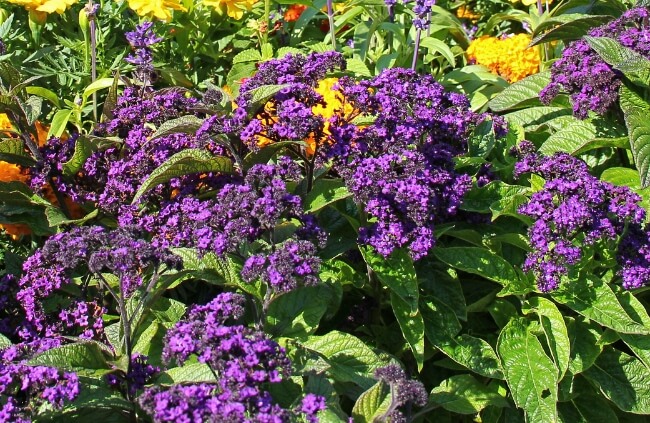Heliotrope cherry pie is an easy-to-grow perennial plant, with an extended flowering period. The heliotrope plant flowers for around eight months of the year, making it an attractive addition to your garden.
Its dense, delicate, flower clusters produce a beautiful vanilla, cherry-like scent, which acts as a nectar magnet for bees and butterflies. It is one of the best smelling flowers in any garden.
This guide outlines how to plant, grow and care for Heliotropium arborescens.
More...
Botanical name: | Heliotropium arborescens |
|---|---|
Botanical family: | Boraginaceae |
Introducing Heliotropium arborescens

Heliotropium arborescens, also known as Cherry Pie, or Garden Heliotrope, are originally from Peru in South America. They are a bushy, upright, evergreen shrub, with wrinkled, dark-green, purple-tinted leaves.
This beautiful perennial grows to a height of between 60 cm to 1.2 m tall and up to 1.5m wide. They don’t tolerate frost or do well in cold temperatures. It shouldn’t be confused with Heliotropium europaeum or Heliotropium amplexicaule, both of which are considered toxic and invasive weeds in Australia.
Cherry Pie Flowers
Heliotrope cherry pie flowers over long periods. It can flower from September through to February depending on where you are based in Australia.
These clusters of flowers have a spectacular scent, smelling of vanilla or baked cherry pie, hence their common name. The deep violet-blue flowers are a magnet for bees and butterflies.
How to Grow Heliotrope Cherry Pie
Ideal Conditions for Growing Heliotrope Cherry Pie
Heliotrope grows well in any fertile, moist, but well-drained soil. Having said that, avoid planting in heavy, wet clay soil if possible. Moist, sandy soil is ideal.
When planting in a pot, use a quick-draining potting soil with lots of organic material.
Where to Position Heliotropium in Your Garden
This attractive shrub works equally well in garden beds or container pots. Given their stunning scent, they are often planted alongside garden paths. Garden heliotrope does well in sun or partial shade.
European guides recommend full sun, but the Australian climate can be harsh and some protection from the hot afternoon sun can be beneficial. It is also worth noting that the Cherry Pie is poisonous.
If you have pets or children, which are partial to nibbling on your plants, you should avoid planting heliotrope in your garden. All parts of the plant are poisonous to humans and animals if ingested.
Heliotrope Cherry Pie Propagation
Heliotrope can be propagated from seed. The best time to sow heliotrope cherry pie seeds is in spring or autumn. Planting the seedlings should be done after the threat of frost has passed. Pinch back the seedlings to ensure you grow nice bushy plants.
How to Care for Heliotrope Cherry Pie

Make sure to water heliotrope regularly, especially during the Australian spring and summer. It’s important though that the soil drains well, and that the plant doesn’t become waterlogged. They don’t like to be drenched.
When heliotrope cherry pie is established, they are fairly low maintenance and reasonably tough. They are somewhat drought tolerant, especially if planted in a shady position. You can deadhead heliotrope to prolong the flowering season.
They can be quite a woody plant and regular, light pruning will keep garden heliotrope from becoming straggly. A heavier pruning can be done in late winter / early spring which will encourage new growth, promote bushiness, and encourage new flowering shoots to develop.
Wrapping Up Our Guide to Growing and Caring for Heliotrope Cherry Pie
Don’t let the toxicity of heliotrope plants put you off. The garden heliotrope is an attractive, low-maintenance plant that adds colour and a wonderful fragrance to your garden.
There is nothing like the vanilla fragrance of the heliotrope cherry pie on a warm summer day. This plant is well suited to grow in most Australian gardens and is reasonably tough.
It does require regular watering, well-draining soil, and some pruning. Get in touch If you have any questions about how to grow heliotrope cherry pie.
Published on August 24, 2023 by Gary Clarke
Last Updated on January 21, 2024




